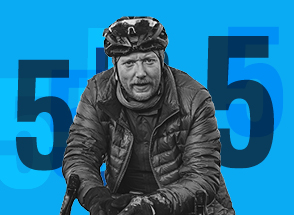Control your debt
We look at why managing your debt is one of the five key building blocks for a financially secure future.

Important notes
This article isn’t personal advice. If you’re not sure whether an investment is right for you please seek advice. If you choose to invest the value of your investment will rise and fall, so you could get back less than you put in.
There’s a four-letter word lots of us shy away from and find incredibly difficult to speak up about – debt.
If your debts get out of control, they can be a serious threat to your financial security. It can prevent you from making the most of your money. What you spend on debt payments could be put away for your future or spent on a better today. So getting on top of debt is one of the top priorities in our 5 to Thrive series.
That’s not to say you should stay clear of debt completely – it has its benefits like putting a roof over our heads. For millions of people, it’s a fact of life. The average household in the UK owes £65,529 of personal debt, including mortgages.
It can be a sensible part of a financial plan. As long as you understand it, have borrowed in the most cost-effective way possible, know how you’re going to pay it off and can afford it.
The key thing is to make sure we don’t let debt get out of control.
Although this article gives you information on managing debt, it isn’t personal advice. If you’re not sure of the best course of action for your personal situation, ask for guidance from a professional.
Key principles for borrowing money
There are a few key principles when it comes to borrowing. The first is that debt is for things you crucially need, rather than those things you want. If the clutch goes in the car you drive to work in, and you don’t have emergency savings to cover it, you might need to borrow to cover the cost. On the other hand, however much you would love a technology upgrade, you don’t technically need them.
It also needs to be affordable. If you’re taking on debts, you need to make a conscious decision to do so, and shop around for the best possible deal. Lenders rely on us drifting into overdrafts or sticking things on a credit card we’ve had for years and paying over the odds for our borrowing.
You need to be clear you can afford repayments. Work through your budget to see how you can free up as much money as possible to pay down your debts as quickly as you can.
A debt spiral
Debt doesn’t just affect our pockets, it can affect our wellbeing too. That’s why we shouldn’t take it lightly. When debt builds up, so can stress and anxiety.
Reports show that nearly half of people in problem debt (where they’re unable to afford their debt repayments) also suffer with mental health issues.
For those who are struggling with problem debt, there is some light at the end of the tunnel. The government launched a campaign called ‘Breathing Space’ to help those struggling with debt.
‘Breathing Space’ offers a 60-day respite period where all interest and charges on debt will be frozen. During this time, debt sufferers won’t face any enforcement or legal action from their creditors. Anyone who’s receiving mental health crisis treatment can also get a longer grace period.
You can find out more about the ‘Breathing Space’ programme on the government website.
Find out more about the 'Breathing Space' debt programme
Five steps to getting on top of your debts
If you’re struggling with debts, there are five steps to help you get on top of it.
- Face the music – We can all find ourselves borrowing too much, whatever stage of life we’re at or whatever our income looks like. Instead of having money left at the end of the month, sometimes there's too much month left at the end of the money. If you’re embarrassed about your debt or really worried about it, it can be tempting to put it to the back of your mind. So the first step is to face up to your debts, work out how much you owe and what you’re paying on your debts.
- Stop borrowing – It might sound obvious, but you can’t deal with any existing debts if you keep adding to them. If your debts have come from incremental overspending, look at your income and outgoings on a weekly or monthly basis. That way you can identify where your money’s being spent and draw up a manageable budget.
- Transfer your debt – If you owe money on a credit card, think about making a balance transfer. A balance transfer is where you move existing debt onto a new credit card at a cheaper rate. Despite changes in the market during the pandemic, if you have a good credit record, you should still be able to get a credit card with promotional offers. Then you can work on paying the debt off before interest is due. If you don’t qualify for these deals, then look for cards with a lower interest rate. The less interest you pay, the more your repayments will go towards clearing the debt. It’s key to double check there aren’t any hidden charges or transfer fees though, so make sure to read the fine print.
- Shop around – It always pays to shop around for the best deals when taking out a loan or mortgage to minimise the repayments. For loans or cards, you can start by using a comparison website to find the best deal to fit your situation. If you’re keen to re-mortgage, you can also use these sites, but you might find a broker will be able to track down a better deal.
- Pay off expensive debts first – Like credit cards, store cards, payday loans and overdrafts. You might be tempted to split your repayments between everyone you owe money to. While you need to keep up minimum repayments, it’s usually a good idea to pay off the most expensive ones first because they’re likely costing you the most in interest. Once that’s cleared, work on the next and so on.
Help available to manage debt
If you or someone you know wants to learn more about managing debt, there are plenty of organisations out there offering help. There are others out there, but here are a few places to start with:
- StepChange – provide free, confidential debt and money guidance. They’ll look at the best solution for your circumstances, support and campaign on your behalf while you deal with your money troubles to reduce the risk of problem debt.
- Citizens Advice – is a free service that will look at options to help you deal with your debt problems. These could be bankruptcy, debt relief orders, debt management plans, administration orders, debt consolidation and Individual Voluntary Arrangements (IVAs). They’ll explain how each option works and if they could be right for you.
- National Debtline – is a charity that gives free, independent debt advice over the phone or online. They also have a useful budgeting tool to help you work out what you have coming in, how much you’re spending and what you have left to pay on your debts.
If you do look elsewhere for debt advice, it’s important to be careful who you go to. Try to look for non-profit debt councillors who are paid to help you, not make money from you.
Keeping on top of your debt checklist
- Make sure you’ve borrowed in the most cost-effective way
- Know how you’re going to pay off any debt
- Check you can afford it
- Make sure it’s part of a sensible financial plan
- Review your levels of debt regularly
Once you’ve on top of your debt, it could be a good time to make sure you’ve got all your protection insurances in place.
Important notes
This article isn’t personal advice. If you’re not sure whether an investment is right for you please seek advice. If you choose to invest the value of your investment will rise and fall, so you could get back less than you put in.




